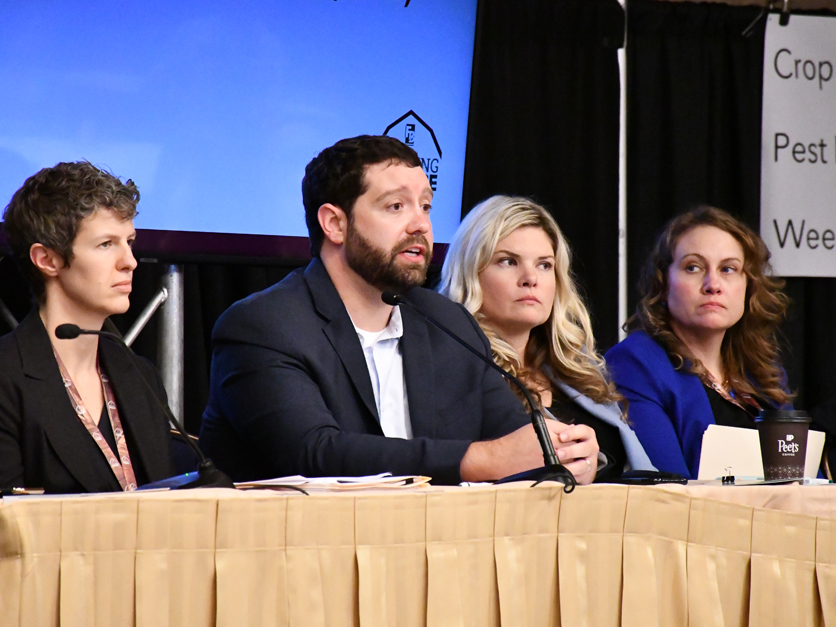Air quality has been on the minds of Californians this year. The record wildfire season has inundated the state with smoke haze, creating a public health crisis never before seen at this scale and upending air quality goals in the San Joaquin Valley.
To assess how it is meeting those goals, the San Joaquin Valley Air Pollution Control District is developing a new report and taking a close look at the progress farmers have made to reduce agricultural burning in the region and whether stricter prohibitions are needed.
Nearly 15 years after the district began enacting prohibitions on ag burning, farmers now find themselves in a losing competition with the state’s forest management policies over the most economically viable alternative to burning.
“As California has moved in the direction of closing some of the biomass plants that convert agricultural waste into electricity,” said Robert Spiegel, a policy advocate for the California Farm Bureau Federation, “it's really left our farmers with fewer options for disposing of those trees and vines that are required to be removed.”
Spiegel explained that in the wake of massive tree die-offs due mostly to the extreme drought the state has suffered, California has required biomass facilities to prioritize waste products from forests. The drought also increased the amount of ag materials to be disposed of. Farmers used to grind these into chips and haul them to the biomass plants where they would produce electricity or power oil production through steam generation.
According to Chris McGlothlin, a policy adviser for the Western Agricultural Processors Association (WAPA), a bill out of the Legislature led to the closure of many plants by requiring 85% of the material to come from forests, leaving just 15% for ag waste.
“Biomass facilities suddenly start disappearing because of those costs,” said Manuel Cunha, president of the Nisei Farmers League.
Generating power through the process of cogeneration suddenly became too expensive to compete with hydroelectric utilities—at more than three times the cost—and was even pricier than nuclear power, he added. Meanwhile, diversion requirements for organic waste are preventing farmers from taking the material to landfills.
Cunha noted that the agriculture community helped to create the air district in 1994, alongside oil producers. They helped consolidate eight separate districts into one to simplify burn permits, rather than having to coordinate with more than 400 local, state and federal agencies, according to Cunha.

Robert Spiegel, policy advocate for the California Farm Bureau Federation
In a September workshop, the air district detailed a direct connection between the closure of biomass plants in recent years and an increase in open burning. The district’s prohibitions had previously slashed ag burning by 80%.
With biomass no longer a viable option, the industry is now experimenting with a range of new technologies to reduce burning in other ways.
In 2018 the air district, in partnership with the ag community, began an incentive program that has since invested more than $8 million in funding for alternatives and has been oversubscribed. The majority of the participation comes from almond growers, with whole orchard recycling growing in popularity, according to the district. Stone fruit growers, vineyard managers and other tree nut operations have been active in the program as well. One of the more promising, but short-term, solutions for agricultural processing facilities is the use of air curtain burners, burn boxes with fans that are designed to filter out most of the smoke. The air district must certify each burner after it is installed.
“We're looking at every and all avenues to be able to get this material away from the facilities,” said McGlothlin. “I've listened to something like 30 different presentations on the latest and greatest technology for this byproduct management.”
WAPA has also supported the air district’s incentives for chipping the material and incorporating it back into the soil. Yet this presents problems as well. Cunha said it changes the pH of the soil, making it more pumice-like, which can create air quality hazards by generating more dust when cultivating or discing a field. For nut growers, harvesters and sweepers suck up and fan out more dust due to the material. The industry has also been investing in low-dust and off-ground harvesters to tackle this issue, though Cunha raised concerns for the future of the technology when the governor is banning the production of diesel engines in the state.
Composting is another potential alternative to burning. This adds more costs to farmers, however, since state water laws have strict requirements for the practice, Cunha pointed out. Composting must be on concrete pads to prevent nitrates from leeching into groundwater, and many small farmers cannot afford to take land out of production and then lay a broad swath of concrete.
Many startups have been pursuing technology for producing biofuel through cellulosic feedstocks, such as wood, grass and crop residues. The process is known as pyrolysis and is more complex than producing standard ethanol from starch-based crops like corn. It also draws agricultural operations into stewarding a new industry.
“Our guys don't want to be running a walnut huller and a clean energy development company that they have to staff,” said McGlothlin.
Cunha emphasized that all of these alternatives to burning require incentives funding to drive the technology innovation.
Another way agriculture has reduced burning is by changing the commodities grown. Cunha explained that in the 1990s about 200,000 acres of raisins used to be dried each year on paper trays in the valley, which were then burned at harvest in late summer, a time when local air quality is already poor. Now farmers apply this process to about 25,000 acres. The rest is mechanically harvested and dried in facilities or allowed to continuously dry on the vine.
Interested in more coverage and insights? Receive a free month of Agri-Pulse West.
The air district does allow some exemptions for a small amount of ag burning on days when the weather disperses the smoke better. Rice, for example, leaves residual stubble that must be destroyed before the next growing season. In regions where water is more abundant, winter flooding replaced the practice decades ago. In the San Joaquin Valley, however, water allocations are often too inconsistent for farmers to plan for flooding, according to the air district. Some apple and pear commodities still require trimmings and other byproducts to be burned to contain diseases.

Chris McGlothlin, policy adviser for the Western Agricultural Processors Association
Food processing facilities, which are not allowed these exemptions, have been investing heavily in alternatives for many reasons, including food safety issues with waste byproducts piling up on the property, creating habitat for pests and violating the Food Safety Modernization Act.
The air district is tracking the efforts to find alternatives as part of a comprehensive analysis delivered to the Air Resources Board every five years. The district’s report is due in December. The district is working with economic consultants to assess the fiscal costs to agricultural operations for the proposed alternatives.
The 2002 California law enacting the prohibitions on ag burning does allow for those regulations to be postponed when farmers have no economically feasible alternatives for eliminating the waste. It also makes an exception when the state or federal governments offer no long-term funding commitment for the continued operation of biomass facilities in the valley or for the development of alternatives to burning.
To Spiegel, the sprawling pursuit of alternatives and the push for incentives dollars to fund innovation is a return to the original issue at hand.
“Why has the state—and the energy regulators in particular—not been as friendly to biomass?” he said, referring to biomass as another source of renewable energy. “Those structures already exist. The infrastructure is already there. There are opportunities that could arguably double the value of biomass energy.”
Spiegel added that “biomass is probably a better alternative than breathing in that particulate matter from a wildfire.”


